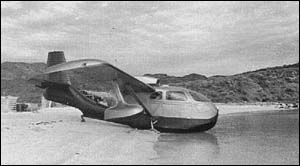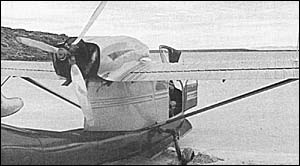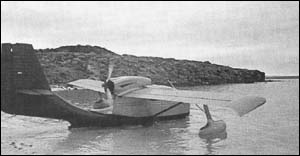This
article will deal primarily with the Republic Seabee, since that
is the aircraft that I am most familiar with. Lake owners may find some
useful information as well. While I don't claim to be an 'expert,'
after some 2000 hours and 28 years operating my Seabee, I guess you
could call me "experienced."
Even
at idle power the Seabee moves through the water at a pretty fair
clip - fast enough to get you in trouble before you can do much about
it when approaching shallow water, especially if it is murky. At the
same time, oil pressure, which makes the prop respond to reverse pitch
inputs, is too low at idle RPM to allow the rapid response you would
want to avoid an obstacle.
To
overcome these dual problems, I recommend moving your reverse
control lever an inch or so out of the forward detent as you approach
an area that might require you to stop suddenly. At the same fime,
adjust the throttle to give you between 1200 and 1500 RPM. Forward
speed is controlled, from this point on, with the reverse lever. You
may have to readjust the throttle to keep the RPMs within the above
limits.
The
speed you choose depends on many factors but the main point is that
you want to be going slow enough to stop if you come to an underwater
obstacle, or at least be going slow enough that you won't do any damage
if you do hit
it.
Let
us assume you are approaching a regular ramp designed for seaplanes
(amphibious type) or a boat launching ramp that will accommodate
aircraft. With the gear extended in deep enough water to insure the
gear doesn't touch bottom until fully extended and locked, you will
proceed until your wheels touch. If all looks well, move the reverse
lever to the forward detent and then come right up on the power to
complete the ramping maneuver.
Beaching
Now
let's talk about beaching. If you are unfamiliar with the beach, I
recommend keeping the gear up and very slowly approaching the shore
until the bottom is contacted (gently, we hope). After it has rested
there, power ahead just enough to slide slightly forward, usually no
more than a few inches.
Now,
shut down the engine and hop out the bow door with a rope tied to
the bow cleat so you can secure it while you check out the beach. As
you deplane, you will notice that the plane (being more buoyant without
your weight) might drift free (the main reason for sliding up the beach
those few extra inches). You will also notice that you are probably 2
to 6 feet from shore and have leaped into a foot or so of water. For
this reason, a good pair of knee length boots are a handy item to carry
on board, or a pair of sneakers you don't mind getting wet. At any
rate, you should have something on your feet for the next step in the
beaching maneuver.
 Waiting for
high
tide predicted by the fisherman who live in the huts in the background
to
be the following morning. Waiting for
high
tide predicted by the fisherman who live in the huts in the background
to
be the following morning. Note the high water mark just behind the tail. |
After
securing the plane so it won't drift away, either with the rope
or having someone stay and hold the plane, check the beach for
firmness. I have found that if I can't stomp my heel into the beach
more than an inch or so it is probably firm enough to taxi out of the
water on your gear.
Assuming
the beach is firm enough, bringing your Bee to shore on the
gear is by far the preferred procedure. Besides eliminating all the
problems associated with securing it in the water and possible damage
from water and wind action, it is very convenient to have your Bee up
on the beach where you can get at your supplies without wading. This is
also the perfect opportunity to impress
everyone with the Seabee's rugged versatility. Done properly, few
things
are as spectacular as a Seabee roaring out of the water to park on a
remote
beach. By the same token, nothing is more embarrassing than to get
stuck
in the process if you have done it improperly or miscalculated. I hope
my
advice will make you look like a hero and not a fool.
Besides
the firmness of the beach, you want to be sure you have enough
clearance for your wings (usually 30 to 40 feet) between the waterline
and brush or trees, and no rocks larger than baseballs. Frequently, you
will have to clear away some rocks and driftwood. ALWAYS plan to bring
your Bee up at a 45-degree angle to the shoreline and make a 90-degree
turn (at least) back toward
the water so it is always heading downhill before you stop. Clear a
path
accordingly.
Now
you're ready for your grand entry. Offload your passengers and
whatever gear you can get to easily to lighten the plane. Have them
stand beyond where
you plan to stop so you won't sandblast them when you make your turn.
Push
the Seabee back until it is just barely floating and then get in while
your
biggest, strongest passenger holds the bow. Start up and reverse off
(with
a shove from your bow tender if needed). Make sure you are in deep
enough
water to allow the gear to be pumped down without contacting the bottom
because
if it does before it is down and locked, you could break the gear
clevis
attachment and be unable to raise or lower the gear hydraulically. (You
could
still lift it to an up and locked position manually for a water takeoff
and
landing but you couldn't move it in flight. You could also force it
down
and locked manually but it would be extremely difficult due to the
buoyancy
of the tires).
As
stated before, approach the beach at a 45-degree angle. When the
gear touches as in ramping, put the reverse lever in the forward detent
and come onto the beach with enough power to allow you to make at least
a 90-degree turn back toward the water without stopping. Try to use
little or no brake when making the turn as this may cause the wheel to
dig into the sand. Also, make sure your tail wheel is unlocked (if it
is the locking type). This is not a major problem if you have forgotten
it, as it will usually drag through the sand OK.
If
you have managed to end up on the beach headed back down toward the
water, you're home free! Set the parking brake, shut down and accept
the accolades of your admiring public. If, however, you become stuck
before completing your 90-degree turn, get it unstuck right away. The
longer it sits the more stuck it is going to get. If it was just a
rock, remove it and complete the maneuver, but if you miscalculated and
the beach was not firm enough, this would be a good time to break out
that folding shovel you carry (you do
have one don't you?) and dig out the sand or obstruction. You might
even want to firm up the footing with some twigs, fir boughs, or
cardboard. The main thing is that you want to get your Seabee out of
the mess NOW. Later it will just be worse.
If
you find yourself very stuck and you're not sure you can power out
with the engine alone, your passengers can help. I would caution you,
however, that your passengers probably aren't as familiar with a pusher
aircraft as
you are and it would be very easy for someone to slip and be hit by the
prop. The safest method for them to help would be to tie a sturdy rope
to the
strut fitting where it attaches to the wing. By pulling from a safe
distance
and well outside of the propeller arc, they would be in no danger, even
if they slipped and fell.
As
you can imagine digging out a stuck Seabee can be a lot of work, so
if in doubt, a more prudent plan might be to leave it in the water.
There are
a number of ways of doing this depending on how long you intend to stay
and if there is a tide or not.
A Beach Too Soft to Taxi Onto
For
short visits with no wind or tide action, probably nothing more is
needed than a line from the nose to something solid on the beach. If
nothing else, you can use your anchor, which you can bury firmly into
the sand. For longer visits I would suggest, in addition to the nose
line, a line from each tiedown ring or wing strut fitting to the shore
to prevent a breeze from swinging the plane into the beach and allowing
a wing float to contact the bottom. If a float is allowed to do this,
you can count on waves or boat wakes
developing that could damage the float bottom or strut. Unless my
Seabee
was in constant eyesight, I would ALWAYS have wing lines attached.
 The right
gear has
rolled into the hole dug for it, waiting for high tide. If the tide
were
not present, and thus not a factor, more digging would be required. The right
gear has
rolled into the hole dug for it, waiting for high tide. If the tide
were
not present, and thus not a factor, more digging would be required.
|
If
the bank is rather steep or gets deep close to shore, I would
suggest that you put the gear down and taxi in until the main gear
barely touches bottom. Don't bring it any closer to shore as this will
raise the nose and lower the tail. Remember that those "water tight"
compartments AREN'T. They are all open at the top of the bulkheads and
if the tail is too low (anything much lower than when it sits on an
airport) water might work its way over the top of the last compartment
and progressively sink your Seabee from the stern. Not a pretty sight.
WARNING! If the water level should drop after securing your Bee (tide,
etc.), the effect would be the same as if you had rolled your wheels up
onto the bottom. A good candidate for the "tail sinking syndrome." For
this reason, I don't recommend the bow to shore method in tidal
water.
Gear Down, Tail to Shore
This
is the most secure method of leaving a Seabee floating in the
water. Tie a sturdy rope to the tie down ring under the tail (or to the
tail wheel itself, if you want something stronger). That's about all
there is to it. The only precaution worth mentioning is that if the
water level should rise after securing your Bee, make sure your rudders
(air & water) won't contact something on shore.
The
extended gear will ensure that it contacts the bottom before
anything fragile does. If the tide goes out, you're aimed downhill in
the right direction. If you have to leave before the tide comes in
again, give it a try. If you get stuck in the mud, you're no worse off
than if you had waited for the tide in the first place. When it comes
in you'll float free and be on your way. No need even to get out and
dig. I was stuck this way a few summers ago at Mole Harbor in Southeast
Alaska where the tides can run 20 feet or more. I had to wait several
hours for the tide to float me free but they were
two of the most enjoyable hours I have ever spent. The water rose at
the
rate of an inch every few minutes. It was fascinating watching the
water flow
rapidly around me and as the water reached 6 inches deep or more, the
spawning
salmon started swimming by me. Taxiing free was no problem after that.
 The moment of truth
when I fired up and powered out.
The moment of truth
when I fired up and powered out. |
I
can't
give you firm guidelines for every situation but perhaps these
techniques will help keep you out of serious trouble. After all, if you
didn't have an adventurous spirit and some pioneering stock you
wouldn't have a Seabee.
Few
things can match the fun and adventure of visiting or camping in
some wild, remote area. The Seabee is the most rugged, versatile
aircraft I know of for this purpose. Go out there and enjoy it. A
plaque I once read said, "A ship in port is safe, but that's not what
ships were made for."